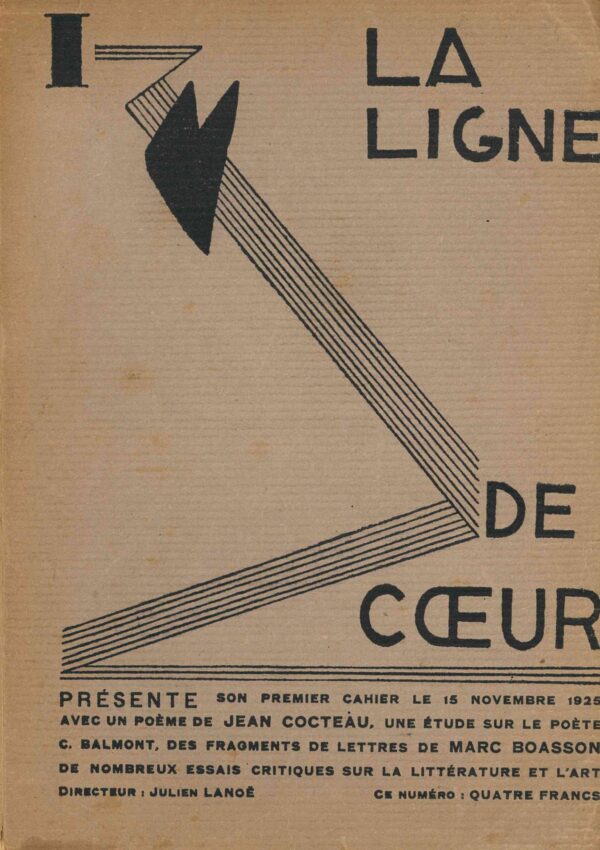
A complete run in 17 total issues of the rare avant-garde literary journal. Octavo (8 x 5 5/8 and 8 3/4 x 5 1/2 inches). Original pictorial wrappers (first series) and original printed self-wrappers (second series). Covers of first issue detached, small loss to front cover of second issue, overall very good. Nantes: self-published, 1925-1928 and 1933-1935. This collection comprises a rare complete run of the literary avant-garde journal edited by Julien Lanoë (1904-1983), French writer and industrialist, and President of the Society of Friends of Musée des Beaux-Arts in Nantes from 1936 to 1970. Issues of the first series range from 62 to 72 pages, and the second series from 8 to 16 pages. The issues are comprised of prose and poetry, with contributions from Jacques Maritain, Maurice Fombeure, Robert Garric, Jean Cocteau, Marc Boasson, Constantin Balmont, Max Jacob, Jean-Marie Terrien, Henri Barbot, Léon Bloy, Roger Lesbats, Georges Hugnet, Claude Cahun, Victor-Emile Michelet, Maurice Sachs, Louis Émié, Pierre Menanteau, André de la Perrine, Jules Supervielle, André Salmon, Gabriel Marcel, Jean Aurenche, Philippe Thual, Alfredo Gangotena, Paul Sabon, Louis Guilloux, Pierre Colle, Edward Millpotts, Pierre Reverdy, Giorgio de Chirico, Georges Syam, André Gaillard, and others. Issue no. 4 contains the first printing of an important and often-quoted article by Claude Cahun, titled "Carnaval en chambre". In the brief four-page essay, she deals with the theme of the mask in art and society. Scarce; as of April 2024, OCLC shows holdings at four North American libraries, not all of which are complete runs.

Groh, Klaus
Two small unpaginated artist's books, signed and dated by Groh. Each booklet 3 7/8 x 2 3/4 inches. Side-stapled gray cardstock, titles handwritten in pencil to front covers and Groh's name rubber-stamped, hand-signed and dated '87 in pencil to back covers. Extremely light soiling to covers, overall excellent. N.p, 1987. Klaus Groh (b. 1936) is a German artist and author who helped bring Mail Art from America to Europe and established an international Mail Art network. He directed the Micro Hall Art Center and the cabaret Literaturium as well as the International Artists' Cooperation (I.A.C.), the latter of which he ran from 1969 to 1990. These two miniature artist's books, titled "Love" and "Hate", are comprised of cut-up pages from a German telephone book, including some personal names and phone numbers as well as advertisements for businesses. They are unpaginated, each comprised of approximately 48 double-sided leaves. These two volumes are possibly unique; as of April 2024, there were no listings for either booklet on OCLC.

Canesi, Giovanni, & Antonio Cassi Ramelli
(3), 162 pp. survey of the use of artificial lighting in modern architecture, profusely illustrated. Quarto (11 x 9 inches). Cloth boards with stamped title to cover. Light soiling and minor handling wear, overall very good. Milan (Ulrico Hoepli) 1934. Profusely illustrated survey of Art Deco and modernist lighting fixtures and both interior and exterior settings for lighting designed by 100 international architects, including Robert Mallet Stevens, Achille Donzelli, Mario Faravelli, Rudolf Fränkel, René Herbst, Erich Mendelsohn, André Salomon, Carlo Enrico Rava, Hans Poelzing, Aldo Viale, Alberto Strozzi, Paulo Buffa, Piero Bottoni, Edgar Brandt, Joseph Urban, and many others. The majority of the illustrations are from photographs, but some also show plans or elevations and other details. There are 216 illustrations total, including 128 of architecture and 88 of fixtures, most in public spaces and in buildings in which lighting is a key feature.

Barr-Sharrar, Beryl & Pierre Lecuire
A remarkable sketchbook with 25 original gouache paintings (there is no work number 14) by Beryl Barr-Sharrar, for Pierre Lecuire. Small oblong octavo (8 1/8 x 5 1/4 inches). Cardboard covers, metal spiral binding. Some light bumping to edges, paintings in beautiful and bright condition, overall excellent. N.p. (Paris), 1968. This beautiful notebook is inscribed inside the front cover, "Pour Pierre de Beryl, 20 Août, 1968, ces 25 esquisses en couleurs". The title is hand-written on the front cover, and a date of 1965 given under Barr-Sharrar's name. There is also a hand-written note from Lecuire, which mentions that Béryl was his neighbor in Paris in the 1960's and was married first to sculptor Roger Barr and then to Bill Rubin of the Museum of Modern Art, and has since returned to New York. Beryl Barr-Sharrar (b. 1935) is an American artist who studied the American Abstract Expressionists in Berkeley and New York before moving to Paris in the 1960's and beginning her career as a professional artist. In 1962 she co-founded the College Art Study Abroad program, and served as its director until she returned to the United States in 1968. She taught painting and printmaking at Mount Holyoke, and in 1970 began studying classical archaeology at the IFA at New York University. She continued to paint and exhibit her work for several years but after 1980, focused primarily on her academic career. A handful of years ago, she returned to exhibiting her work as a painter with a three-person show in Long Island City, in 2016. Her work was exhibited at the Lucian Durand Gallery in 1967, and of her paintings it was said, "Beryl Barr-Sharrar's work has the vigor and know-how of American action painting at its best, and the refinement of color of the School of Paris. The result is both captivating and awe-inspiring." Pierre Lecuire (1922-2013) was a French poet and publisher who collaborated closely with numerous artists to design and publish beautifully crafted books. It is unclear how exactly Lecuire and Barr-Sharrar crossed paths, but perhaps he became aware of her work during those exhibitions in Paris in the late 1960s. The 25 small paintings in this sketchbook showcase Barr-Sharrar's study of Abstract Expressionism and her bold use of color. A beautiful and unique volume of original art.

Paris: 1945-1951. Octavos (19 x 12.7 to 21 x 14 cm). Original printed paper wrappers, housed in fitted archival slipcase; 16, 16, 40, 46, 30 pp. Some light toning, overall excellent. A rare complete collection in five fascicules of the Surrealist magazine under the editorial direction of French poet Michel Fardoulis-Lagrange. Cofounded with Jean Maquet, and with the collaboration of René de Solier and Raoul Ubac, five total issues were published. Speaking later on the spirit behind the journal, Fardoulis said "Nous avions fait une croix sur le sartrisme et le surréalisme, l'un pour sa conception de l'engagement, l'autre pour ses manifestations scandaleuses. Nous voulions nous situer ailleurs, dans le domaine de l'extériorité, c'est-à-dire dans le mythe du langage." He and Maquet chose the title after a famous line from André Breton, and meant to signify not a complete departure from Surrealism, but a slight shift in direction and approach. The issues contain brief works of prose and poetry with an occasional illustration, with contributions from Fardoulis, Maquet, de Solier, and Ubac, along with Francis Picabia, Louis Richet, Pierre Fallot, Georges Bataille, Marcel Lecomte, Georges Hénein, Georges Lambrichs, Antonin Artaud, René Char, Roger Gilbert-Lecomte, Jean Pfeiffer, Arthur Adamov, Raymond Michelet, Jean Grenier, Robert Cregut, Charles Cuits, and Yves Bonnefoy.

Roma/Foligno: Franco Campitelli, 1931. Duodecimo (19.2 x 13.2 cm). Original illustrated wrappers with cover illustration by Mario Mafai; (2), 432, (4) pp. Some signatures coming loose from binding, overall very good. A small Futurist Italian art almanac, conceived of and compiled by Carlo d'Aloisio da Vasto. This volume features a colver illustration by Mario Mafai and writings by Luciano Folgore, Corrado Pavolini, Luigi Bartolini, C. Govoni, Alfredo Casella, G.B. Angioletti, Alberto Sartoris, Massimo Bontempelli, Vincenzo Costantini, Gerardo Dottori, Anton Bragaglia, and others, as well as illustrations by numerous artists including Morandi, De Pisis, Carrà, Casorati, Soffici, Spadini, and A. Martini. Other volumes were published in 1930 and 1932, but as of October 2023, OCLC locates only 2 holdings of the 1931 almanac in North American libraries.

The single unique issue published of the special journal devoted to Marinetti, 4 pp., edited by Mino Somenzi, containing a "Manifesto per le Onoranze Nazionali a F.T. Marinetti", an homage to Marinetti by Marco Ramperti, poetry, and other articles with titles such as "Lo spirito profetico di Marinetti", "L'influenza mondiale di Marinetti e del Futurismo", and "Il significato del I Congresso futurista." Scattered illustrations. Some creasing, toning, small closed tears and edgewear. Elephant folio. Original self-wrpps. N.p. (Milan) (Cavenaghi & Pinell) n.d. (1924). Mino Somenzi was an early member of the Futurist movement. He founded and directed the Istituto Fascista di Propaganda Nazionale in Milan in 1923, and continued his involvement with Futurism after moving to Rome in 1926. In 1929, he was among the editors of the Manifesto dell'Aeropittura Futurista, along with Marinetti, Balla, Fortunato Depero, Gerardo Dottori, Fillia, and others. In May 1932 he founded the important journal "Futurismo", which became the official publication of the Futurist movement. In 1933 he organized the first national Futurist art exhibition at Piazza Adriana in Rome. As of January 2020, WorldCat locates only 4 holdings of this unique publication in North American libraries.

Paris: Éditions Réverberes, 1928. Octavo (21 ×13.5 cm). Original printed wrappers; unpaginated (33 pp.) including a frontispiece after a drawing by Jean Marembert. Overall very good condition. Limited edition of 300 copies. Rare volume of poems published by the neo-Dadaist group Les Réverbères, which was founded in December 1937 by Michel Tapié, Jean Marembert, Jacques Office, Pierre Minne, and Henri Bernard, and which promoted Dadaist exhibitions, jazz concerts, stage performances, and published literary works. Among the exhibitors were: Louis Cattiaux, Marembert, Pierre Minne, Tapié, as well as members of the "La Main à plume" surrealist group: Noël Arnaud, Marc Patin, Jean-François Chabrun, and others. Among other events, the group also organized "Tribute to Dada" soirées, which featured readings of texts by Tristan Tzara, Ribemont-Dessaignes, and others. In "Art of the Defeat: France 1940-1944," Laurence Bertrand Dorléac asserts that the group still met for several gatherings retaining the spirit of the 1930s even after the German occupation of France in June 1940. The Neo-Dadaist activities around Michel Tapié have not been explored to any significant degree and are rarely mentioned in passing in the literature on Dada and Surrealism. One exception is Michel Fauré's book "Histoire du surréalisme sous l'Occupation", published in 1982. The reason for the sparse state of research is probably that the experimental, elaborate avant-garde prints, most of which were produced in very small editions, are hardly accessible due to their rarity. Very scarce; as of December 2023, OCLC lists only 2 copies in North America.
![Graficheskie kompozitsii [Graphic compositions]](data:image/gif;base64,R0lGODlhAQABAAAAACH5BAEKAAEALAAAAAABAAEAAAICTAEAOw==)
Small volume of movement study drawings in a Constructivist and Cubist-influenced style. Oblong octavo (6 3/4 x 10 3/8 inches). Original printed wrappers. Light browning, minor soiling to covers, small areas of wear and loss along edges and spine, some staining near staples, light scattered spotting to interior, overall very good. Leningrad: n.p., 1929. Little is known about the artist who created these images. However, there is a three-page introduction that precedes the 48 figure studies titled "Synthesis of Form, Dynamics of Action, Rhythm of Lines", in which Vekstein discusses the sense of movement he instilled into some of his drawings. He mentions the curves of the figures of laundresses echoing the curves of the iron and the fabric, or the swing of the shovel, scythe, or hammer by a worker. Other rounded lines evoke music, speed, or vibration. The studies are clearly taking inspiration from Constructivist and Cubist art in their style and interpretation. A fascinating sketchbook; as of April 2024, we could find no records of this work on OCLC.


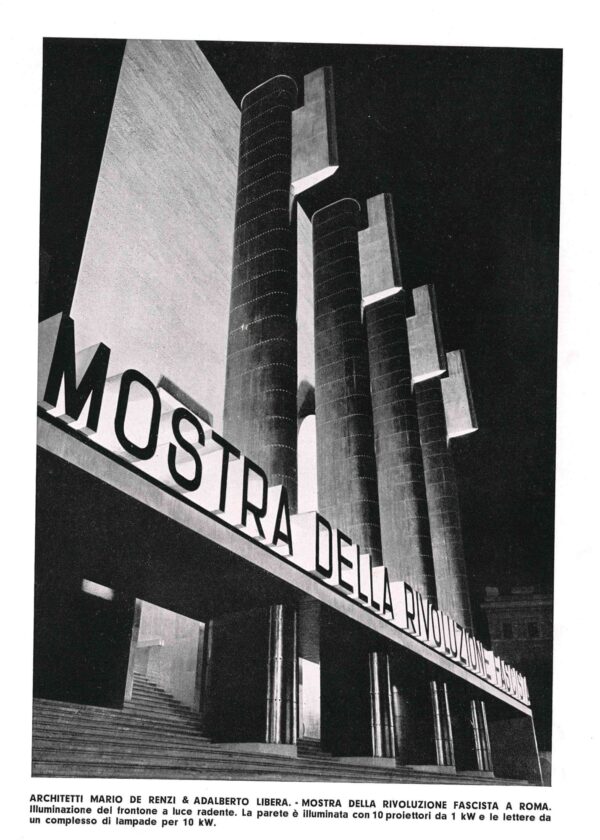
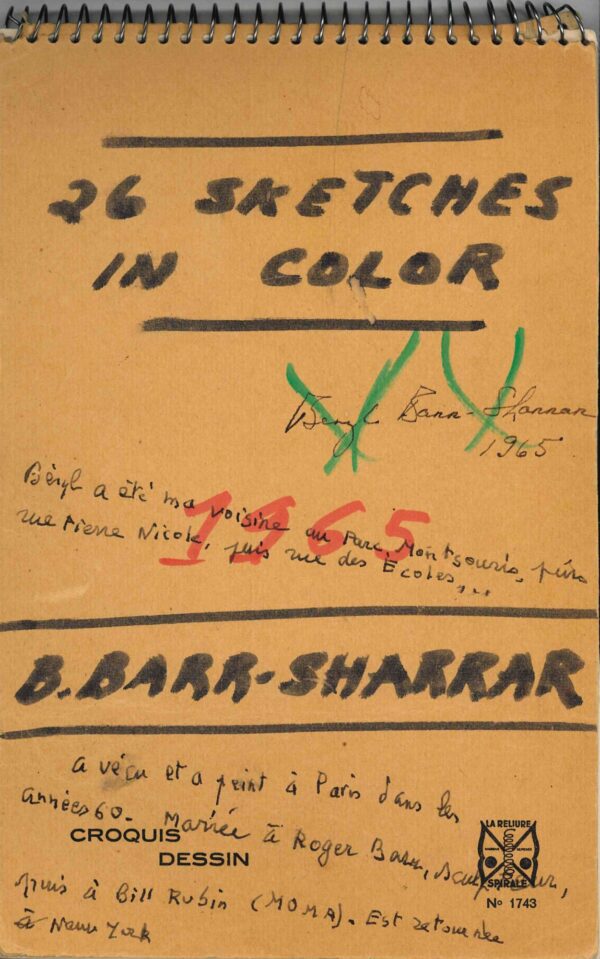
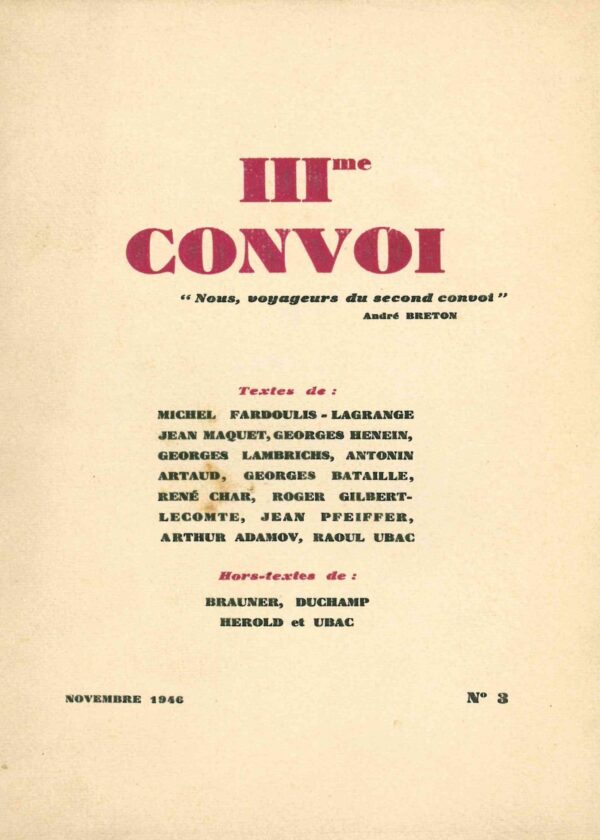


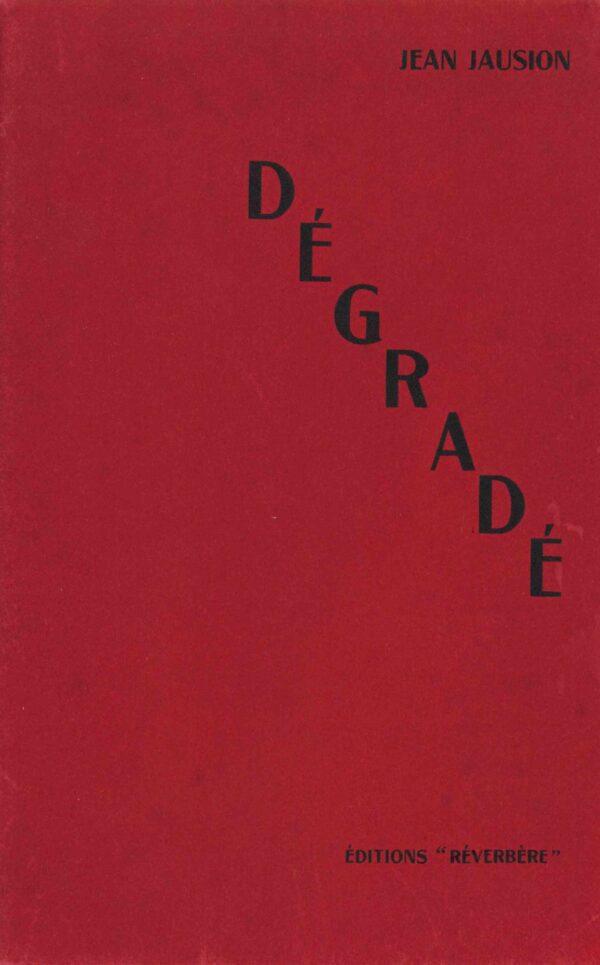
![Graficheskie kompozitsii [Graphic compositions]](https://rarebookinsider.com/wp-content/uploads/2024/05/31861223977.jpg)